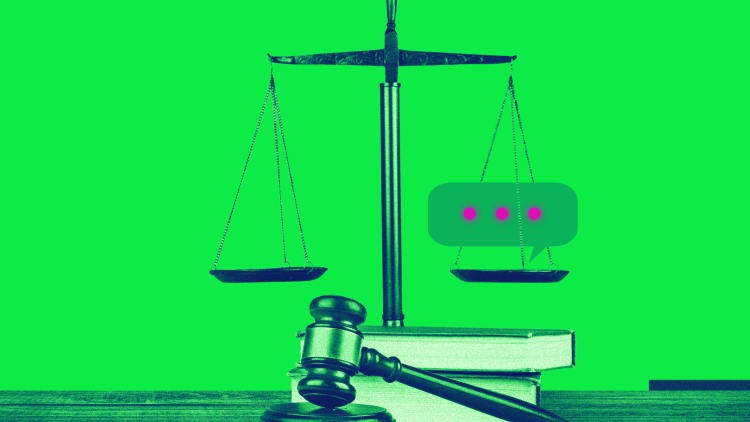- | 8:00 am
Is the lawyer of the future a GenAI bot?
Probably not, but AI can help lawyers today and in the future.

With analysts at a big Wall Street firm saying that generative artificial intelligence (GenAI) technology is about to automate almost 25% of jobs across every industry, many people are saying, “Is that us?” If you are a lawyer today, or teaching the next generation of lawyers, you have probably been asking that question for more than a year.
As the CEO of a legaltech software company, I am in the AI business. As someone with an advanced degree in computer science, I am also an AI pragmatist. I understand both the potential and limitations of GenAI technology, and try to keep a realistic view of all points on the spectrum of possibility.
While there’s a decent chance that, in the indeterminate future, GenAI-powered litigation tools could sift through millions of evidentiary documents, find the “smoking gun,” and autonomously build a structured narrative for a case, I’m not going to speculate about those what-ifs. Instead, I’m going to share what real legal teams are saying about GenAI and its potential in their field. Their opinions are based on their expertise as legal practitioners, and their experience with GenAI tools on real matters today.
It democratizes the litigation process
Gordon Calhoun is one of those lawyers. He is an e-discovery expert with over 45 years’ experience as a litigation and trial attorney, and is a recently retired partner at Lewis Brisbois, one of the 100 largest law firms in America.
With AI review tools and writing assistants, Gordon told me, “gone are the days of spending 15 minutes summarizing a 50-page document or scouring through lengthy PowerPoints [presentations]. [These tools] have revolutionized our approach, providing our legal teams with deep insights into complex, voluminous data in record time.” An AI-powered e-discovery tool can typically produce these kinds of summaries in less than 30 seconds.
“[AI e-discovery tools] have also democratized the litigation process,” he continues. “Those involved in document review do not need to be skilled with respect to the subject matter of the data at issue.”
In speaking with Gordon, “democratized” is the word that caught my ear. Putting these powerful tools in the hands of nonprofit organizations and underdog plaintiffs (Erin Brockovich comes to mind) can provide access to justice in ways that were never before possible—a force today that will only become more powerful in the future.
It helps find the needle in the haystack
Greg McCullough is an underdog, and proud of it. He is an independent litigation consultant working in fire litigation, representing people, individuals, businesses, or insurance companies that have been impacted by wildfires caused by another company. It’s personal to him, as his parents lost their house to a San Diego wildfire years ago.
Greg is currently using AI-powered e-discovery tools to help with his work related to large fires, including the Maui fire in Hawaii, the Marshall fire in Colorado, and many others. Like Gordon, Greg says that “AI is an efficiency tool. It’s onerous to read a 1,000 page contract or document. AI can do it in a fraction of the time it would take me, and provides valuable information that I can take action on.”
That includes sentiment, which means extracting the emotional component of text, such as whether someone appears happy or sad, or likes or dislikes something. “Sentiment is one of the most valuable tools,” he says. “I can search for what a company admits in their own words what they are or aren’t doing correctly.”
Sentiment analysis is a GenAI capability that can help Greg gain evidence to prove liability and negligence. “In a big case I might have 10 million documents—a lot to parse through,” he says. “AI helps me find the needle in the haystack and review large stacks of documents; sometimes the important thing is on page 792 out of 1,000 pages.” Greg then uses AI to provide context; “I make summaries of the sections of the document to direct me to the most useful sections,” he says.
Fact finding, creating context, and developing a narrative—all of these steps are necessary in building successful legal cases, and all can continue to be made easier and more effective in the future with AI.
There is no single solution
That litany of steps is quite telling. There is no one AI system—at least, not yet—that can address all of these issues in a single interface. The best AI experiences are deeply integrated into existing workflows and designed to solve specific problems reliably, given the necessary context. Thus, interaction with AI is not a sea change, like talking to HAL (the creepily sentient robotic being in Stanley Kubrick’s 1968 film 2001: A Space Odyssey) anytime you have a problem. Instead, it’s a series of interactions in the systems you already use, in which the AI helps you solve the problem at hand better than you might alone.
Tech providers need to step up to this challenge by cutting the hype, focusing on concrete use cases, and identifying the very real challenges at hand—including being more transparent in sources, and educating users on how to use GenAI more confidently and in which workflows.
Using AI responsibly is everyone’s responsibility; while it’s not yet clear what role GenAI will ultimately have in law, I am excited to play a role in finding out.
AJ Shankar is CEO of Everlaw.






































